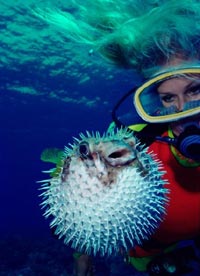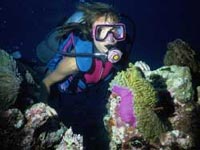|
1. The Alternatives
(27░43.84'N, 34░11.93'E)
A chain of flat topped reefs, also known as 'seven pinnacles'.
Best dive around third and fourth where current sweeps through
feeding pristine corals with bright vivid colours. 'Stingray
Station' lies at the western extremity of the Alternatives, an
irregular reef owes its name to the gathering of stingrays in
March-April. Often sightings of a leopard shark.
 2.
Wreck of Dunraven
(27░42.15'N, 34░07.30'E) 2.
Wreck of Dunraven
(27░42.15'N, 34░07.30'E)
At the southern extreme of 'Shaab Mahmoud' lies the wreck of the
72m English steamer sunk in 1876 on its way to Bombay. The hull
lies upside down and is totally covered in corals (max. depth
29m). Morays, groupers and schools of glassfish and goatfish
inside.
3. Small Passage
(27░43.91'N, 34░05.86'E)
Small split in midway of Shaab Mahmouds barrier. The tide
empties and fills the inner lagoon twice daily, thus creating
strong currents that promote an impressive explosion of life.
Brilliant soft corals and resident flashlight fish also make it
a premier night dive location - weather permitting.
4. Wreck of SS Thistlegorm
(27░49.90'N,33░55.23'E)
Most famous wreck in the Red Sea. The 129m English freighter was
bombed by German aviation in 1941, fully loaded with supplies
and arms for troops in North Africa. Has created an artificial
reef on a flat sandy bottom, home to a large variety of marine
life and schooling fish - max. depth 31m.
5. Shag Rock
(27░45.50'N, 33░53.30'E)
Large circular reef offering excellent diving on pristine coral
reefs from any location on its perimeter. The sheltered southern
point is the most dived location offering the opportunity for
drifts along the west or east boundaries.
6.
Wreck of Sarah H.
Weather permitting the northern point hosts the wreck of the
'Sarah H.' just below the surface (max. depth 12m). Large
schools of yellow goatfish, oriental sweetlips and regularly
patrolled by palargics.
7. Bluff Point
(27░40.07'N, 33░48.32'E)
At the gate of the Straits of Gubal, 'Bluff Point' draws its
name from the turbulance created by strong currents that beat
the eastern most wall of the island. Huge fan corals cover an
impressive drop off with caves and glassfish. Often sightings of
turtles and napolean fish.
 8.
Abu Nuhas 8.
Abu Nuhas
Also named the 'Ships Graveyard', houses several wrecks on a
sandy seafloor at the bottom of a steep sloping coral reef
layered with table corals:
Gianus D.
(27░34.71'N, 33░55.41'E)
Greek freighter that hit the reef in 1983. Most dived wreck
leaning to port with a fully intact stern section. Impressive
engine room packed with glassfish. Be weary of numerous
lionfish, scorpianfish and strong surges in and around the wreck
in rough weather - max. depth 27m.
Carnatic
(27░34.81'N, 33░55.63'E)
An old English steamer which sank in 1869. In stark contrast to
the other more modern wrecks in design and fully encrusted in
hard and soft corals - max. depth 27m.
Sea Star
(27░34.92'N, 33░55.76'E)
Sank in 1976, fully laden with stone floor tiles. Early morning
divers may find a white tip reef shark sleeping under the rudder
at the stern. Be weary of very limited and small entry/exit
points into the engine room - max. depth 25m.
Chrisoula K
(27░34.98'N, 33░55.88'E)
Struck the reef in 1981. Lying completely on its starboard side
exposing its huge hull on one side and gaping cargo holds on the
other. Large morays live in the scattered remains of wreckage on
the starboard side and batfish circle the top side - max. depth
31m.
9. Yellowfish Reef
(27░33.99'N, 33░56.01'E)
A group of three small reefs and outlying pinnacles on the
inside of Abu Nuhas lagoon offering a superb landscape filled
with schools of yellowfishes like goat, butterfly, banner and
oiental sweetlips which give its name.
 10. Shaab Umm Usk
(27░34.99'N, 33░53.25'E) 10. Shaab Umm Usk
(27░34.99'N, 33░53.25'E)
A large horseshoe shaped reef shelters a shallow lagoon and
offers good shallow diving on coral gardens at either point.
Further around the southern reef exterior provides a steep coral
encrusted wall sloping to 40+m. Playful bottlenose dolphins
inside lagoon at times.
11. Blind Reef
An Isolated reef south of Siyul Island, with good diving on its
north side. Soft coral, whip coral, glassfish bommies and
turtles often found.
12. Siyul Kebira
The north eastern point offers a plateau which slopes gently
from 10m to 30+m. Sharks and large rays often sighted in the
deeper water, with schools of oriental sweetlips and masked
butterflies in the shallows. |